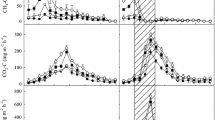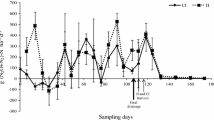Abstract
This research aims at elucidating the greenhouse gas emissions and its related soil microbial properties in continuously flooded or intermittently drained paddy soils in Japan and Indonesia. The study in Japan comprises alluvial soil and peat, cultivated to rice variety Nipponbare, while in Indonesia comprised alluvial soil cultivated to rice variety Siam Pandak. Intermittent drainage was performed to half number of the plot in 6 days interval, starting at tillering or heading stage of rice, while the other half number of plot was kept flooded as control. The experiments were carried out to follow the randomized block design with three replications. Gas samples were taken in weekly basis, except during the treatments (i.e., every 2 days interval) and analyzed for methane (CH4) and nitrous oxide (N2O) concentrations. Soil samples were and analyzed for the population of methanogenic bacteria, denitrifiers, methane production and consumption potentials, and methanogenic substrate. Plant growth parameters were also observed. The results showed that intermittent drainage significantly reduced greenhouse gas emission from paddy soil of Indonesia and Japan without significant changes in soil microbial population. The reductions of greenhouse emission from Japanese peaty and alluvial paddy soil due to intermittent drained were about 32 and 37%, respectively. Meanwhile, the reductions in greenhouse gas emission from alluvial soil of Indonesia due to intermittent drainage were very similar to that of in Japan, i.e., average about 37%. This suggests that intermittent drainage can be an appropriate technology option to reduce the greenhouse gas emission from paddy soil in Japan and Indonesia.



Similar content being viewed by others
References
Alexander M (1982) Most probable number method for microbial population. In: Pages AL (ed) Method for soil analysis, part 2. American Society of Agronomy, Inc., Madison, WI, pp 815–820
Asakawa S, Koga Y, Hayono K (1997) Enumeration of methanogenic bacteria in paddy field soil by the most probable number (MPN) method. Soil Microorganism 47:31–36 (in Japanese)
Boundia LV, Neue HU, Wassmann R, Lantin RS, Javellana AM, Arah J, Xu Y, Makarim AK, Corton TM, Charoenship N (1996) Understanding the nature of methane emission from rice ecosystem as a basis for mitigation strategies. In: proceedings of international symposium on maximizing sustainable rice yields through improved soil and environmental management, Khon Kaen, pp 291–314
Bouwman AF (1990) Introduction. In: Bouwmen AF (ed) Soil and the greenhouse effects. Wiley, New York
Chithaisong A, Inubushi K, Muramatsu Y, Watanabe I (1996) Production potential and emission of methane in flooded rice soil microcosm after application of straw. Microbes Environ 11:73–78
Cicerone RJ, Oremland RS (1988) Biogeochemical aspects of atmospheric methane. Glob Biogeochem Cycles 2:299–238
Conrad R (1995) Soil microbial processes involved in production and consumptions of atmospheric trace gases. Adv Microb Ecol 14:207–250
Furukawa Y, Inubushi K, Ali M, Itang AM, Tsuruta H (2005) Effect of changing ground water levels caused by land-use changes on greenhouse gas flux from Tropical peatlands. Nutr Cycl Agroecosyst 71:81–91
Hadi A, Inubushi K, Furukawa Y, Purnomo E, Rasmadi M, Tsurata H (2005) Greenhouse gas emission from tropical peatlands of Kalimantan. Nutr Cycl Agroecosyst 71:73–80
Harris RC, Gorham E, Sabacher DI, Bartlett KB, Flebbe PA (1985) Methane flux from northern peatland. Nature 315:652–654
IPCC (2001) The scientific of climate change. http://www.ipcc.ch/
Miyake M (1982) Improvement and management of peat soils in Japan. In: Proceedings of international symposium on distribution, characteristics and utilization of problem soils, pp 243–250
Moore TR, Knowles R (1990) Methane emission from fen bog and swamp peatland in Quebec. Biogeochemistry 4:45–61
Mosier AR, Duxbury JN, Freney JR, Heinemeyer O, Minami K (1996) Nitrous oxide emission from agricultural fields: assessment measurement and mitigation. Plant Soil 181:95–108
Nugroho SG, Lumbanraja J, Suprapto H, Ardjasa Sunyoto WS, Haraguchi H, Kimura M (1994) Effect of intermittent irrigation on methane emission from and Indonesian paddy field. Soil Sci Plant Nutr 42:609–615
SPSS (1996) SYSTAT 8.0. SPSS Inc., Chicago, USA
Tsuruta H, Yagi K, Kanda K, Hirose K (1995) Nitrous oxide emission from rice paddy fields. In: Program and abstract of international symposium on soil-source and sink of greenhouse gases, Nanjing, China, p 12
Watanabe I, Hashimoto T, Shimoyama A (1997) Methane-oxidizing activities and methanotrophic populations associated with wetland rice plants. Biol Fertil Soil 24:261–265
Yagi K (1997) Greenhouse gas emission and absorption. In: Konno T, Anzai T, Onikura Y et al (eds) Methods of soil environment analysis, Hakuyusha, Tokyo, pp 129–138 (in Japanese)
Yoshida T (1984) Microbial metabolism in rice soils. In: IRRI (ed) Soil and rice. IRRI, Los Banos, Philippines, pp 445–436
Author information
Authors and Affiliations
Corresponding author
Rights and permissions
About this article
Cite this article
Hadi, A., Inubushi, K. & Yagi, K. Effect of water management on greenhouse gas emissions and microbial properties of paddy soils in Japan and Indonesia. Paddy Water Environ 8, 319–324 (2010). https://doi.org/10.1007/s10333-010-0210-x
Received:
Revised:
Accepted:
Published:
Issue Date:
DOI: https://doi.org/10.1007/s10333-010-0210-x




